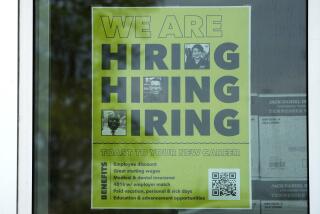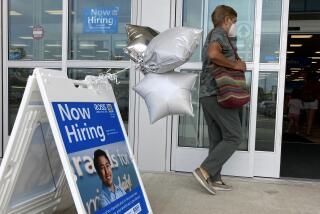U.S. jobs report takes on outsize significance
WASHINGTON — On the first Friday of every month, at precisely 8:30 a.m., the Bureau of Labor Statistics flicks a switch and the latest clue about the U.S. economy — the jobs report — gets transmitted all over the world.
And then the frenzy begins.
Politicians in Washington race for the mikes to proclaim that the economy is back, or maybe falling into an abyss. Investors from Brussels to Bangkok win and lose billions. And in American factories, offices and living rooms, you can almost hear a collective groan of dismay or sigh of relief.
This Friday will be no different when the April jobs report is released.
In ordinary times, the report might be seen for what it is — a good if imperfect snapshot of the nation’s labor market.
But in a presidential election year, and after 4 1/2 years of recession and grueling recovery, the data have taken on outsize significance. Many pundits say, though without conclusive proof, that the direction of the unemployment rate in the months before a presidential election is a good predictor of the outcome.
Friday’s report will get especially close scrutiny by economists and political operatives trying to get a clearer reading on whether the economy, after strengthening at the start of the year, faded in the spring, as it did in each of the last two years.
Until the March report came out, the jobs story had been going President Obama’s way. The unemployment rate had dropped steadily, from 9.1% in August to 8.2% in February. But then the rate stayed flat in March, and a disappointingly weak 120,000 net new jobs were created.
Concerns that Friday’s report could be a repeat downer were heightened Wednesday after Automatic Data Processing Inc., a payroll processor, said its survey showed 119,000 private-sector jobs were added in April, the smallest increase since last fall.
Other forecasters are more upbeat, saying 125,000 to 175,000 jobs were added — about what’s needed to keep up with the population growth and keep the jobless rate from rising.
If fewer than 100,000 jobs were created, expect presumptive GOP presidential nominee Mitt Romney, who tends to be quiet when the job news is good, to have a lot to say. And look for gold investors to spring to life.
“The gold market’s been quite quiet in the last eight weeks, but that could all change this Friday,” said Thomas Paterson, chief economist at the London brokerage Gold Made Simple.
He figured that a bad jobs report would push a wait-and-see Federal Reserve to launch another round of big bond purchases to spur growth, something traders see as driving up inflation and gold prices.
For many Americans, worries abound that the economy may be heading for another spring stall. Officially, the economy has been recovering from the recession since June 2009, but it hasn’t felt like that to many people.
“There’s tremendous anticipation” surrounding the monthly report in the White House, said Jared Bernstein, former chief economist to Vice President Joe Biden. “Your performance gets heavy evaluation based on this report.”
As part of the Labor Department’s elaborate and tightly controlled protocol for handling the report, the White House gets the data Thursday afternoon in two stages: first the 24 tables of employment statistics and then the written release. Obama’s top economic advisor, Alan Krueger, briefs the president Thursday night.
The Federal Reserve also sees the jobs report a day ahead, though no one will say exactly how. Former Labor Secretary Robert Reich said Alan Greenspan, who was Fed chairman from 1987 to 2006, had cultivated “moles” in the Labor Department who gave the data to him.
Greenspan wouldn’t confirm or deny that, though he said in an email reply, “On many occasions, that availability prevented the Federal Reserve from being blindsided by financial market-moving events.” A spokesman for current Fed ChairmanBen S. Bernankewouldn’t comment.
The Commerce Department sees the report 30 minutes before its release. So do a couple of dozen journalists who are locked in a windowless room at the Labor Department, their BlackBerrys and iPhones confiscated until the atomic clock hits 8:30 a.m. and connectivity to laptops and computers is restored.
For all the security and intrigue behind the release, the question remains: Is the report worth all that attention?
Many say yes. “Employment is the single most important economic attribute that helps or hurts people,” said Harry Holzer, a public policy professor at Georgetown University and chief economist at the Labor Department in the Clinton administration.
Even so, Holzer and other experts pointed to lots of caveats. The monthly data are revised in each of the next two months, then a third time about a year later. For 2011, these revisions substantially boosted average monthly job growth.
The unemployment rate seldom gets changed from month to month, but economists note that, statistically, a swing of 0.2 percentage point in either direction is insignificant.
What’s more, the rate can rise or fall for reasons that have little to do with hiring. Sometimes, as in recent months, the jobless rate has been nudged down by a large number of people dropping out of the job market. Only workers who are actively looking for jobs are counted as unemployed.
The headline employment numbers also don’t say anything about the quality of jobs added or lost. And this year, the unusually mild winter weather has made the monthly changes even harder to interpret.
Bernstein, the former administration economist who is now a senior fellow at the Center on Budget and Policy Priorities, thinks the job-creation number will be closer to 130,000, though he knows all too well that forecasting is sometimes a risky business.
In early 2009, Bernstein and others on Obama’s economic team forecast that the president’s $800-billion stimulus package would hold the jobless rate to 8%. But by October that year, the rate had climbed to 10% — something that Republicans delight in pointing out.
The 8% prediction was a big political mistake, Holzer said, but he noted that “people should be careful in assigning credit or blame” when it comes to the jobless data.
Then again, when Holzer was in the Clinton administration in 1999 and the unemployment rate hovered around 4%, “We in the administration took credit for that,” he said.
More to Read
Inside the business of entertainment
The Wide Shot brings you news, analysis and insights on everything from streaming wars to production — and what it all means for the future.
You may occasionally receive promotional content from the Los Angeles Times.











